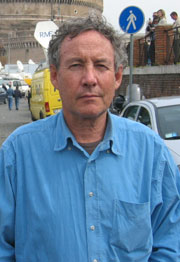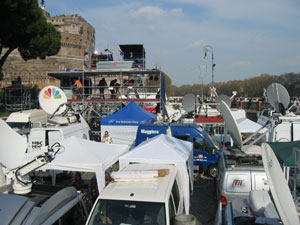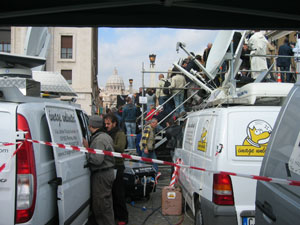 |
 | ||||||||||
Death of a Pope, from ground level
|
 |
|||||||||
|
As the first satellite trucks lumbered into position, and bright lights started appearing on every terrace that had a decent view of the St Peter's cupola, it suddenly became clear that this was really it. All the years of preparation - arguing with owners of buildings, haggling with networks, sweating over what gear to lay aside - had led to this. The pope was clearly dying. Two hospital visits earlier in the year had spurred even the most hesitant foreign news editors into action. There would be no element of surprise. Satellite trucks materialized from every country in Europe and the Balkans, many of them on the prowl for loose clients. It soon became clear however that we were set for an enormous anti-climax. The story was eminently boring. It was going to drag on, and there wasn't much to say.
The bullying EBU - the European Broadcasting Union, an exclusive club for European state broadcasters (Americans could join too but only as associates) had spent years nagging the Vatican and pulling every string to shut out independent operators. It arranged its own exclusive camera positions, both with a terrace and a grandstand, right in the piazza at St Peter's.
The Europeans watched in astonishment as the American networks, which had been annoyingly cheap all year, suddenly threw silly money at everything that moved. Most networks sported just under a dozen crews, but many had to worry about an invasion of affiliate crews - in the case of the ABC there were thirty of them - all wanting feed slots. The skies above the eternal city must have vibrated at night with digitalized voices booming into the galaxy to be bounced back down to hometowns across America.
The latecomers resolved the problem by creating towers of concert scaffolding, building them higher and higher to reach over front positions. The stench and roar of generators, the shouts of semi hysterical producers, and the clash of steel from the tower constructions were all nothing compared to the invasion of the faithful - many of them Polish - who wandered freely through the satellite village gaping at the operators and tripping over cables. Incredibly, police refused to take action, and one night the invasion was so intense that visitors occupied our canopied offices, then set up camp around the trucks. Two of our satellite engineers were unable to leave their trucks for sleeping bodies.
But did anyone have anything to say?
As the endless babble of the on-air correspondents floated high over the Vatican it seemed more and more evident that television news was listing even worse than the leaky ship it was trying to report on. No one was out getting any real stories. As has become the fashion, no one wanted to leave their live spot for fear of being outdone by their colleagues. So there was no time to go and dig up stories. I felt bad for one veteran Italian video editor, Sirio Segatori, who's built a fine reputation for his rapid-fire tape cutting. With a cigarette in the corner of his mouth and a drink perched on his SX machine, Sirio could edit anything, anywhere, in any language. Now he was reduced to being a soundman on a live crew, lulled by the monotonous tones of the reporters "This was to be my big moment" he said, " and not one edit - not one!"
Owning a satellite news gathering truck or a broadcast camera used to separate the men from the boys, in the late seventies. But now they've reached plague proportions - and the competition is tough. The governments - either through their telecommunications giants like BT or Globecast, or through allegedly non-profit organizations like the EBU, have used taxpayers funds to ruin the business.
And what of the coverage itself? Did it merit those hours and hours of bland coverage, with journalists interviewing journalists who had only recently arrived?
No wonder listeners in the UK (and probably many other places) called in to the BBC to complain about the wall-to-wall coverage.
There were however the occasional visual highlights. Some thought the funeral scene was masterful in its variety of colours and choreography - all those wonderful robes and hats! Was this so different from how it must have been among the Mayans or the ancient Egyptians? One colleague said it reminded him of the cantina scene from Star Wars.
As the days passed the microphone chatter got duller and duller, until finally the election of a new Pope began. That also turned out to be a dull affair, but not for everyone. One US network reporter described the wait between the white smoke and the announcement of the new pope as the most exciting moment of his journalistic career. I wish he could have seen the Sandinistas streaming into Managua in 1979.
Sorry, this show was just all too predictable.
The new Pope was a familiar face from the financial powerhouse of the church in Europe - Bavaria. He was also head of the Inquisition - now known as the Congregation for the Doctrine of the Faith. I remember him well from the eighties when I reported on the Brazilian worker priests of the harsh inland areas where violent landowners killed peasants and priests alike. Ratzinger's biggest kill, ecclesiastically, was Leonardo Boff - promoter of the theory of liberation who was dutifully silenced by the Vatican. Forbidden to open his mouth.
A German Pope was terrible news for the long-suffering journalists of the German ARD office in Rome. Unable to pack up and go to a new story like everyone else, they had to brace for a seemingly never-ending story and send for reinforcements.
As for me, I don't know to this day how I got sidetracked into satellite news gathering, but this story was my swan song, and I'm getting out. Anyone want to buy a stack of satellite gathering equipment?
© John Arden
Dispatches are brought to you by Canon. Send Canon a message of thanks. |
||||||||||
Back to May 2005 Contents
|
|



